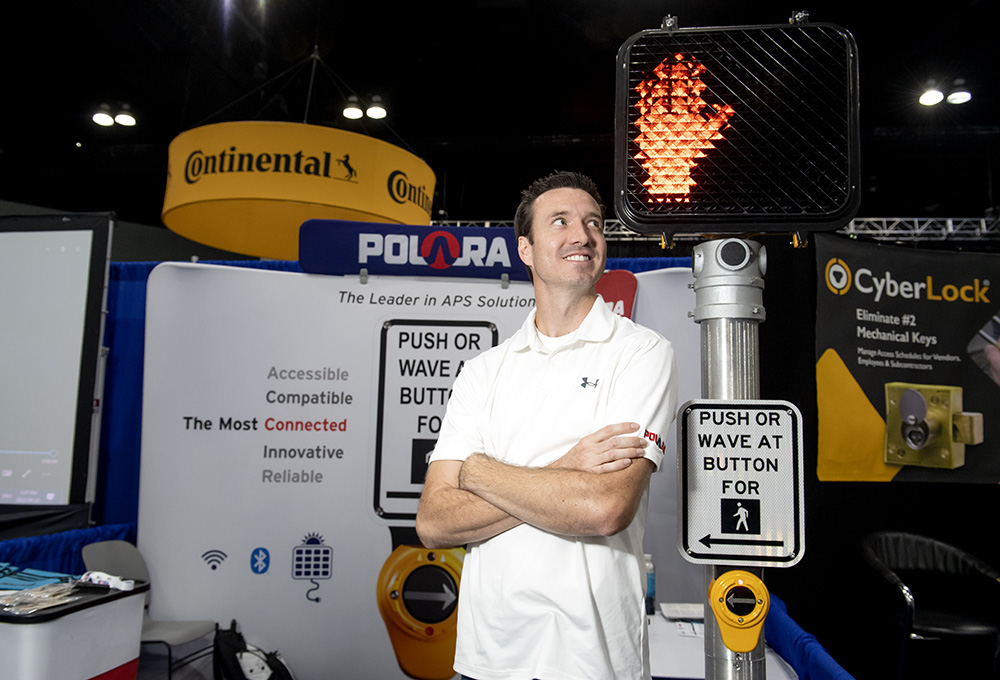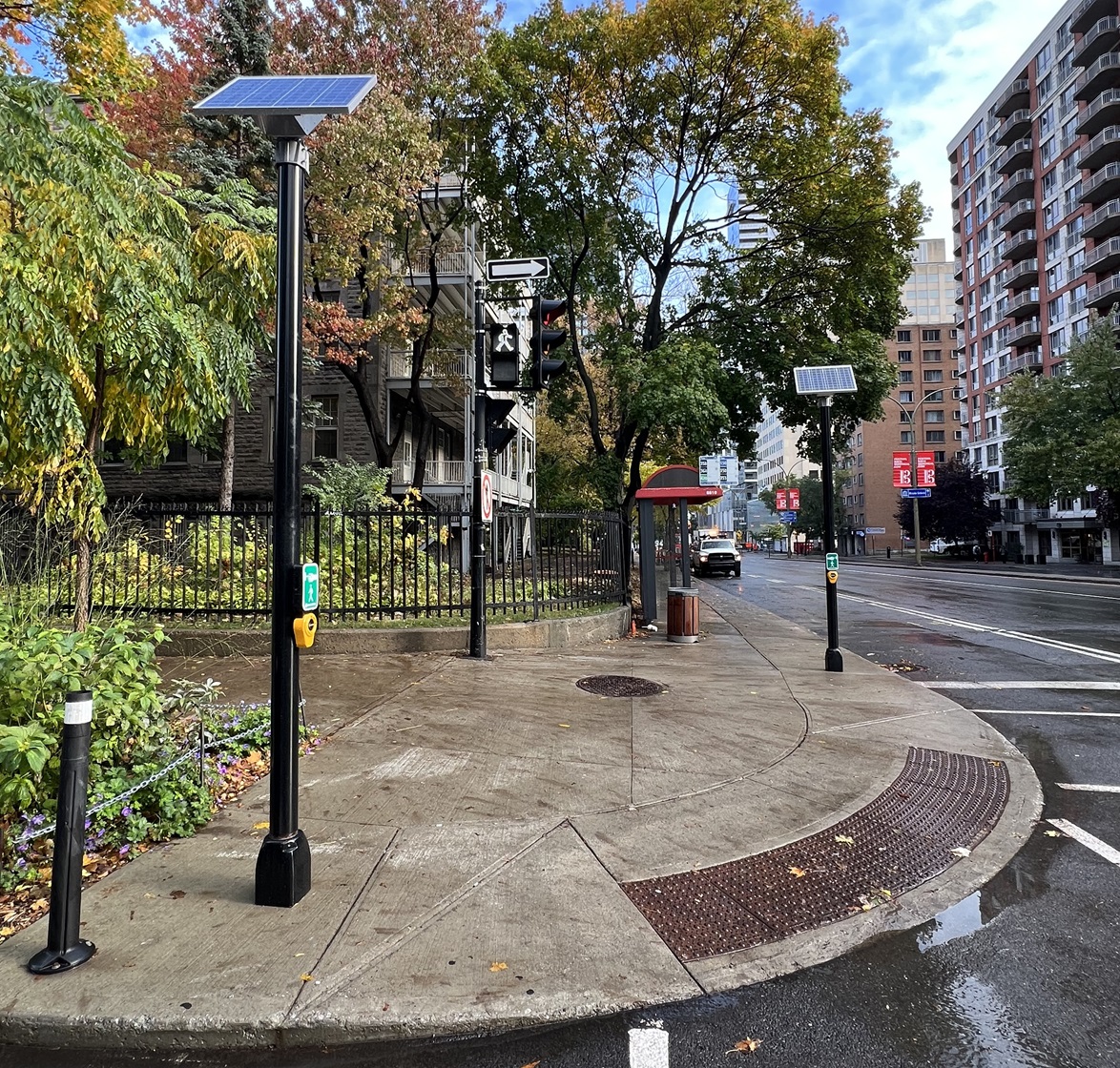
Sue Crawford, an active and proficient traveller who also happens to be blind, has the following to say about the challenges she faces when navigating around city streets these days: “Today cars are largely silent. Some engines shut off when stopping at a red light so one cannot know it is there. Signal cycles are variable and cars are nearly always moving, so it is nearly impossible to listen for audible cues. An accessible pedestrian signal [APS] is an absolutely necessity today.”
Happily for Crawford and other US citizens with visual disabilities, new accessibility guidelines, designed to ease some of the uncertainties and risks they face when crossing the street, will soon be encoded into law.
At this point they become mandatory at the local, state and federal level in the US, obliging those tasked with installing and maintaining pedestrian signals to deploy the latest compliant APS equipment.
Safer navigation with APS
The provision of APS (devices that translate visual pedestrian information into sensory formats to enable people with visual disabilities to navigate cities safely and comfortably) is a topic close to the heart of Dr. Billie Louise "Beezy" Bentzen, director of research at Accessible Design for the Blind, a consultancy dedicated to improving accessibility for pedestrians with disabilities, primarily through human factors research.
In some cases, it has taken years of work to understand what cues and sounds work best. Establishing exactly how to help pedestrians with vision disabilities navigate safely to the end of a crossing, for example, has been a tricky issue to resolve and one that has been the focus of much of the consultancy’s research.
Speaking on a webinar hosted by Polara Enterprises, a maker of ADA-compliant, pedestrian-friendly crosswalk devices, Bentzen explains: “In our research on APS, it was easy to let people know when that walk interval was on - but helping them actually get across the sidewalk straight and end up where they wanted to be was really hard. We tried a number of things that would enable that and none of them worked very well. The only thing that did was having a louder walk tone [and] a louder locator tone during the pedestrian change interval that comes from the opposite end of the crosswalk only. Where you have an excessively long crosswalk, where it is a bit diagonal and where there’s not traffic that is parallel to that crosswalk or the intersection is skewed in some way, then an audible beacon is extremely helpful to get people straight across.”
“Install APS because it’s the right thing to do. Don’t wait for Prowag to be adopted”
Beezy Bentzen, Accessible Design for the Blind
Such cutting-edge human factors research is the latest in more than three decades of study dedicated to evolving pedestrian crossings to be as usable and safe for the visually impaired as possible.
The findings of such research have contributed the Public Right of Way Accessibility Guidelines (Prowag) for implementing the Americans with Disabilities Act (ADA) with regard to sidewalks, crosswalks pedestrian signals and other public pedestrian facilities to ensure they are equally accessible to - and usable by - all pedestrians.
Closing the guidance gap
Prior to the August 2023 publication of Prowag, the technical requirements for pedestrian facilities was lacking, leaving state and local governments to determine on their own how best to comply with the ADA’s mandate. Prowag fills this long-standing gap, providing transportation engineers and planners with actionable guidance.
The US Department of Justice and US Department of Transport will adopt the guidelines, at which point they will be legally enforceable. From here on in, when pedestrian signals are installed or altered, or if pedestrian signals are added to a crossing, a Prowag-compliant APS must also be added. There is, unfortunately, some uncertainty surrounding what is meant by an ‘alteration’, Bentzen notes.
“An alteration is defined as a change to a pedestrian facility in an existing pedestrian right of way that affects or could affect pedestrian access, usability, or accessibility. That is incredible vague and it is left up to local jurisdictions to decide. I hope the DoT will give us more guidance on what alterations trigger installation of APS.”
Agencies and municipalities which specify and procure pedestrian signalling will also need to be aware that there will be some misalignment between the requirements contained within Prowag and the current edition of the US traffic control ‘bible’: the Manual on Uniform Traffic Control Devices (MUTCD). A notable difference between the two is that Prowag now makes it clear that what are guidelines within MUTCD have become mandatory requirements.
A new edition is due to be published soon but the final discrepancies between Prowag and MUTCD may take longer to be ironed out completely, warns Bentzen. “We don’t know what the final MUTCD will be so there is a fair amount of uncertainty right now. In about two years they will all be saying the same thing.”
What are the key requirements for Prowag?
The good news is that Prowag harmonises with the MUTCD in key areas. These include requirements for:
• A method of activation (either a push button that activates accessible features when pressed or a passive detection device that detects pedestrians and activates accessible features automatically)
• A device that provides audible indications of pedestrian signals (either a percussive tone or speech message)
• A push button with a ‘high visual contrast’ tactile arrow that vibrates during the walk phase
• A locator tone that helps individuals who are blind or have low vision locate the push button
• Operable parts that must be operable with one hand and not require tight grasping, pinching, or twisting of the wrist
In addition to APS, which Prowag requires to be installed wherever pedestrian signals are installed or altered (commonly at intersections and crossings equipped with pedestrian hybrid beacons), it also requires audible information at locations where pedestrian activated warning lights are installed or altered.
These devices must activate a speech message that indicates the status of the beacon. They must not include vibrotactile features indicating a walk interval, as warning devices are not signals and do not stop traffic.
Under Proawag, crosswalks at multi-lane roundabouts and channelised turn lanes are now required to have additional treatments that alert motorists to the presence of pedestrians, or that slow or stop traffic at those crosswalks. These can be:
• A traffic control signal with a pedestrian signal head
• A pedestrian hybrid beacon
• A pedestrian actuated rectangular rapid flashing beacon, and/or a raised crossing
The new guidelines also render some APS equipment non-compliant. Examples include those that lack vibrating high visual contrast tactile arrows on the push button and speaker-type APS that lack locator tones. “Regular ADA-compliant push buttons are not APS so as we move forward these do not provide the Prowag-required features,” Bentzen notes.
She adds that Prowag also requires specific positioning of APS - as mispositioned APS can confuse or mislead pedestrians, defeating their purpose.
Smart phones, distracted users
We may all be beneficiaries of the new guidelines, suggests Matthew Baker, vice president of sales at Polara. “APS is not just of use to those with visual impairments,” he suggests. “As everyone knows, pedestrian fatalities have risen [in the US]. Among the contributing factors is distracted pedestrians. That audible indication can be good for everyone. If you’re looking at your phone and not paying attention to the visual signal, if a rapid percussive sound happens or a speech message, hopefully that gets your attention and gets you out into that crosswalk quicker without delay.”
Given the obvious benefits, there is now a clear moral as well as a legal imperative for agencies and municipalities to act now, observes Bentzen. “Install APS because it’s the right thing to do. Don’t wait for Prowag to be adopted,” she urges. “Discrimination against people with disabilities, such as the failure to provide accessible and useable information - including pedestrian signal information - has been required since 1973. A failure to provide APS cannot be justified by not having scoping and technical specifications published by the DoT.”
Since 2007 San Francisco, New York and Chicago have all been found liable for violating the ADA by failing to provide enough APS and each city has been required to speed up provision, Bentzen points out. “You can’t say ‘we don’t have to do it because that standard is not out yet’,” she concludes. “You are required to provide accessibility.”
Click here for more detail on the specific requirements of Prowag











